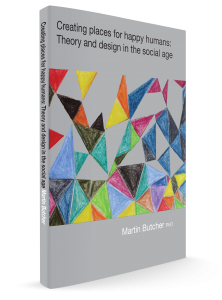Commencing with the observation that currently not all is well with the planet, this book describes a change approach derived from the historical context in which we exist today. This historical understanding is described through a reading of European architecture and city form over the ages. From this understanding the emerging discipline of participatory development grounded in complexity theory is identified, with conceptual models, tools and techniques described from 20 years of working in the field.
It is a truism that architecture reflects the contemporary conditions of society. The buildings constructed have meaning relevant to the people that construct and inhabit them. This is most apparent and illustrated through the structures created by traditional cultures. However the history of contemporary culture illustrates that whilst culture evolves over time, the buildings that remain are testament to their conceiver’s original thoughts, beliefs and reality. It is from an analysis of the European city and its buildings that the author identifies three distinct periods of social/cultural zeitgeist occuring over the last 1000 years.
The book describes these periods as behaving like waves of change, each waxing and waning in their own right. Each reaching a zenith in which it most fully embodies the thoughts and beliefs of almost all in their time, before gradually losing credibility to an emerging new. The transition periods between one golden age to the next are characterized by turmoil and confusion as the establishment look to maintain the status quo, whilst something new and subsequently completely different emerges from the periphery. It is within these transition periods that parts of two ages co-exist and meld.
In their time Galileo, Copernicus, Newton all challenged established thought and were responsible for the development of scientific endeavor, a discipline that transliterated into a culture that both describes and venerates change and growth and individual control and choice within a technological frame. Contemporary society is characterized by the intrinsic value placed on technical solutions to problems, and the associated prowess of those that hold that technical proficiency.
Whilst at the one time limited to developing products, those involved have uncovered a new and possibly historically unique discipline, that of design, whilst simultaneously a new way of learning – that is, Action Learning or Action Research. In traditional cultures learning was through either memorizing oral history or the study of texts, whilst products were created according to established laws and expertise. Design results in creating new answers to multivalent problems, and for those involved in the process, a new learning and understanding emerges.
More recent scientific thought and understanding incorporate ideas of relativity and complexity. Ideas that can accommodate both differing values and degrees of ‘rightness’. There is an emerging cohort of development practitioners that embody these principles and ideas. A key component of which is the idea of creating safe spaces and places for others to express their own opinions, ideas and concerns regarding a shared problem, leading to an agreed or sustainable decision or direction.
In this book the author identifies two key theoretical models relevant for the time, and provides over 20 tools and techniques that can be used as a practitioner’s tool box from which to design conceptual places for others to work together. This is augmented by final chapters reflecting on twenty years of practice in the field, and concluding on what potential implications this emerging design discipline might have for the built environment itself.

